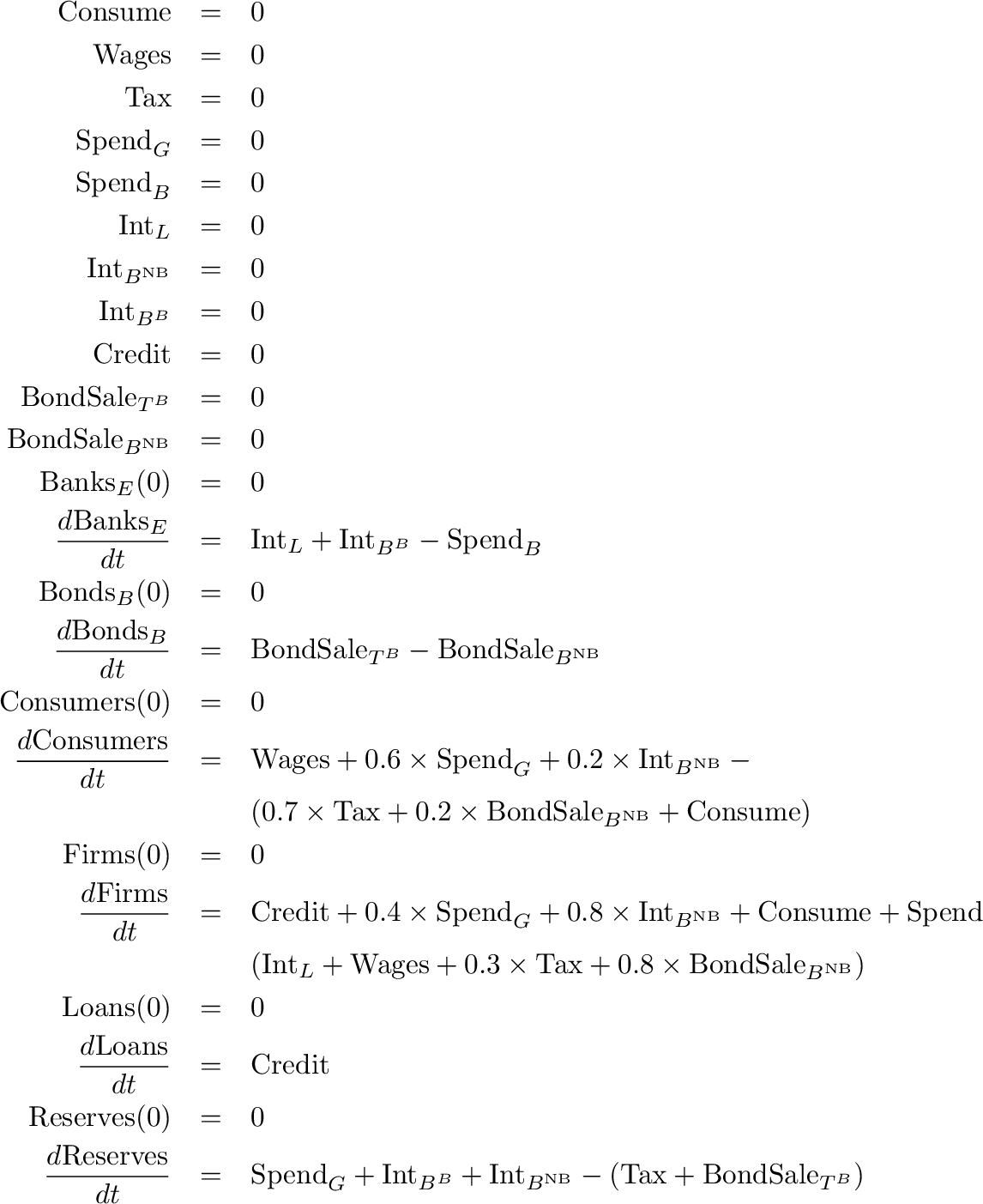



Next: Minsky's unusual system dynamics
Up: If you are experienced
Previous: If you are experienced
Contents
Godley tables are a unique feature of Minsky. They are based
on what could be called the world's first GUI (``Graphical User Interface''),
the accountant's double-entry bookkeeping table.
Double-entry was invented in 15th century Italy
to enable accurate recording of financial transactions. The essence
of this method is (a) to classify all of an entity's accounts as either
Assets or Liabilities, with the difference between them representing
the Equity of the entity; and (b) to record every transaction twice,
once as a Credit  and once as a Debit
and once as a Debit  ,
where the definitions of Credit and Debit entries for Assets, Liabilities
and Equity are designed to ensure that the transaction was accurately
recorded. Minsky uses this GUI to generate stock-flow consistent models
of financial flows, but by default uses plus
,
where the definitions of Credit and Debit entries for Assets, Liabilities
and Equity are designed to ensure that the transaction was accurately
recorded. Minsky uses this GUI to generate stock-flow consistent models
of financial flows, but by default uses plus  and
minus
and
minus  operators (though the accountant's convention
of Credit
operators (though the accountant's convention
of Credit  and Debit
and Debit  can be chosen
via the Options menu). This system guarantees that, no matter how
complex the model is, the equations are internally consistent.
can be chosen
via the Options menu). This system guarantees that, no matter how
complex the model is, the equations are internally consistent.
Minsky uses this GUI to generate systems of ordinary differential
equations to model financial flows. The columns specify stocks, while
the entries in rows are flows. The symbolic sum of a column
is thus the rate of change of the associated stock. Minsky
takes a table like the next figure:
![\includegraphics[width=\textwidth]{images/GodleyTableSingle}% WIDTH=527 HEIGHT=275](img313.png)
And converts it into a set of dynamic equations, which by construction
are ``stock-flow consistent'':

The model is completed by defining the flows on the canvas.
In addition, because one entity's financial asset is another's financial
liability, Minsky enables the construction of a multi-sectoral
view of financial transactions. The wedge next to every account name
is used on other tables to search for Assets that have not yet been
recorded as a Liability, and vice versa. For example, the previous
Table recorded the financial system from the point of view of the
Banking Sector, for which Reserves—the deposit accounts of private
banks at the Central Bank–are an Asset. Reserves are also a liability
of the Central Bank, and that can be shown in Minsky by adding
an additional Godley Table, naming it Central Bank, and recording
Reserves as a Liability:
![\includegraphics[width=\textwidth]{images/GodleyTableSecondIncomplete}% WIDTH=527 HEIGHT=246](img314.png)
At this stage, the financial transactions have been entered only once—against
the Central Bank's Liability of Reserves. Each transaction has to
be entered a second time to complete its record, but at present there
are no available accounts in which to record the transactions a second
time.
![\includegraphics[width=\textwidth]{images/GodleyTableSecondIncomplete}% WIDTH=527 HEIGHT=246](img314.png)
Bond purchases by the Central Bank indicate the need for to show bonds
owned by the Central Bank as an asset, while the other transactions
indicate the need to show the Treasury's account at the Central Bank,
the ``Consolidated Revenue Fund'', as an additional liability:
![\includegraphics[width=\textwidth]{images/GodleyTableSecondComplete}% WIDTH=527 HEIGHT=214](img315.png)
This is an inherently better way to generate a dynamic model of financial
flows than the flowchart method used by all other system dynamics
programs, for at least four reasons:
- All financial transactions are flows between entities. The tabular
layout captures this in a very natural way: each row shows where a
flow originates, and where it ends up;
- The program imposes the rules of double-entry bookkeeping, in which
entries on each row balance to zero according to the accounting
equation
 . If you don't ensure that
each flow starts somewhere and ends somewhere, then the program will
identify your mistake;
. If you don't ensure that
each flow starts somewhere and ends somewhere, then the program will
identify your mistake;
- The double-entry perspective assists in the completion of a model,
since the requirement of a matching entry for each transaction indicates
the accounts that are needed to complete the accounting; and
- Double-entry bookkeeping acts as a prohibition against recording invalid
transactions.
Minsky thus adds an element to the system dynamics toolkit
which is essential for modeling the monetary flows that are an intrinsic
aspect of a market economy.




Next: Minsky's unusual system dynamics
Up: If you are experienced
Previous: If you are experienced
Contents
 and once as a Debit
and once as a Debit  ,
where the definitions of Credit and Debit entries for Assets, Liabilities
and Equity are designed to ensure that the transaction was accurately
recorded. Minsky uses this GUI to generate stock-flow consistent models
of financial flows, but by default uses plus
,
where the definitions of Credit and Debit entries for Assets, Liabilities
and Equity are designed to ensure that the transaction was accurately
recorded. Minsky uses this GUI to generate stock-flow consistent models
of financial flows, but by default uses plus  and
minus
and
minus  operators (though the accountant's convention
of Credit
operators (though the accountant's convention
of Credit  and Debit
and Debit  can be chosen
via the Options menu). This system guarantees that, no matter how
complex the model is, the equations are internally consistent.
can be chosen
via the Options menu). This system guarantees that, no matter how
complex the model is, the equations are internally consistent.
![\includegraphics[width=\textwidth]{images/GodleyTableSingle}% WIDTH=527 HEIGHT=275](img313.png)

![\includegraphics[width=\textwidth]{images/GodleyTableSecondIncomplete}% WIDTH=527 HEIGHT=246](img314.png)
![\includegraphics[width=\textwidth]{images/GodleyTableSecondComplete}% WIDTH=527 HEIGHT=214](img315.png)
 . If you don't ensure that
each flow starts somewhere and ends somewhere, then the program will
identify your mistake;
. If you don't ensure that
each flow starts somewhere and ends somewhere, then the program will
identify your mistake;